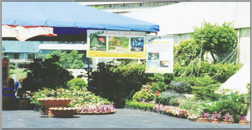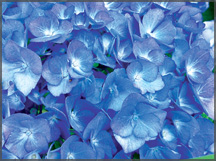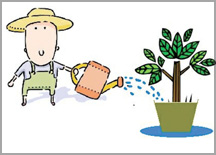|
dailynews |
|
|
|
|
|
OTHER LINKS |

|

|

|
|
'Farm and Garden 2007'EXHIBITION: Discover the joy of a warm, bright and shady spots on sunny days and the pleasure of a green garden well beyond the commercialised environment at 'Farm and Garden' show organised by Sri Lanka Exhibition and Convention Centre (SLECC) for the second consecutive year from March 8 to 11 at SLECC opposite Lake House Colombo 10. This Farm and Garden show which is endorsed by the Central Environment Authority and Industrial Development Authority will showcase a gamut of nurseries, Green Houses, agricultural equipment and tools, flower gardens, vegetable cultivation, seeds, chemicals, fertilisers, aquariums, ponds, waterfalls & fountains, landscaping and garden furniture, etc.
This trade exhibition will be an ideal opportunity for farmers, gardeners and nature lovers and homebuilders to diversify their interests into economical aspects. Visitor profile will consist of Government Agencies, Corporates, Housewives and the general public. The SLECC is of the view that by organising such an event Sri Lankan blue chip companies and Small and Medium scale enterprises will get an opportunity to meet and discuss with targeted buyers and sellers locally as well as from the South Asian region. Whether you have space for gardening or not, the SLECC will provide you with the best solution to have your own unique mini garden, indoor as well as outdoor. The vendors have gathered a fine selection to match all the above needs. Flower of the week: Different shades of HydrangeasHydrangea is native to North and South America, Himalayas, and central and eastern Asia. Hydrangea is beautiful, perennial bushes with huge flower heads. These deciduous bushes profusely produce huge, round flower heads in mid-summer.
Most varieties of Hydrangea grow from 3 to over 10 ft. tall. Some varieties grow up to 25 feet. Most varieties prefer full sun to partial shade. Colors include white, pink, blue lilac, purple, varying shades of these colors, and a variety of two tones. There are over 1200 species of Hydrangeas. Hydrangeas are easy to grow. They prefer full sun to partial shade. In warmer climates, put them in a more shaded area, to reduce wilting in the midday sun. They prefer moist, rich, loam soil that drains well. When planting, add generous amounts of rich compost. Flowers will begin to bloom in mid summer. Remove spent blooms. This will promote more blooms. To grow bigger blooms, thin some of the stems. Garden Guide: Watering Plants: Using water responsibly in your gardenWATERING a garden is something most people do as relaxation. Often, the hose is running while our thoughts wander aimlessly. Much precious water has flowed wastefully, meanwhile. Some gardeners are not satisfied until they have thoroughly drenched the leaves, forgetting that leaves are not designed to absorb water and that plants have roots for this purpose!
Gardeners are some of the more profligate users (mis-users?) of water and it would be useful to reflect on our old habits and attempt to change. How much water is enough for plants is not often an easy question to answer. It depends on a number of factors, such as the prevailing temperature, relative humidity, wind speed, the plant, type of soil, among other factors. Since most of the water is lost by evaporation, the observed rate of loss is around 3-7 litres per day per square meter for most parts of the country. Therefore, to replace this loss and to provide for plant requirements, around 10-12 litres per square metre of garden is an adequate quantity to apply daily. However, please note that these are upper limits and you may be able to get by with less, depending on your particular garden and the prevailing weather. To understand this subject in a little detail, let us analyse what happens in nature. Water falling on the ground goes into the soil ('infiltration'), while a portion may flow off along the surface, referred to as 'run-off'. Part of the infiltration is absorbed by the soil while any excess seeps out of the bottom (and all over the carpet if you don't have a drain tray!). A soil that is just wet to the point that nothing drains out is considered to be at 'field capacity' and is the goal that should be aimed for during watering. Plant growth is also best at this level of soil moisture. After water is absorbed by the soil, it may go several ways. The soil holds on to most of it through absorption, a portion is absorbed by plants and a portion evaporates. In addition, plants release water absorbed from the soil through their leaves by a process called 'transpiration'. It has been estimated that 98% of the water absorbed by a plant is lost by transpiration. You may consider this wasteful, but this is one of the forces that help the plant to absorb water and nutrients. Evaporation through the leaves creates a force called the 'transpiration pull', which pulls water from the roots into the rest of the plant. If evapo-transpiration is a major reason for drying of soil, the intelligent thing to do is to water at times when evaporation is lower. In many dry areas and at times when it is hot and rains are scarce, it is common to irrigate at night. It is cooler at night and the stomata on the leaves are usually closed, therefore evapo-transpiration losses are significantly smaller. Plants can absorb water at night, because of chemical forces which help absorption of water by roots. Proof of this phenomenon is the dew found on leaves in the early morning. Any drainage is wasteful in terms of water as well as nutrients and we can, with a little practice, find out how much water to apply to a pot. For those metrically inclined, apply a measured quantity of water to a dry pot until it starts to drain off. Then measure the drained water and subtract it from the quantity applied. The remaining value will give you an indication of how much water the soil can hold and this quantity should not be exceeded during watering. Alternatively, if you are using a hose, time your application such that no water drains out of the pot. For a garden, after watering, dig about 15 cm and see whether water has seeped down and it is sufficiently wet at this depth. Adjust the duration of watering accordingly. Soil too vary in their capacities to hold water and it is common knowledge that clay retains wetness for long periods. This means that we must ensure a certain proportion of clay, usually 1/3rd of the medium, as this helps retain moisture. Organic matter in the form of compost, manure, coir fibre etc also holds large quantities of water. Therefore, using a well balanced growing medium is one way of ensuring economical use of water. Another simple method of keeping the soil moist is to cover the surface with a mulch of leaves or straw or coir fibre. The frequency of watering is another variable. In most parts of the country, watering once a day is sufficient. Do not be fooled by a dry soil, as it is often only the surface that is dry - just dig below the surface with your fingers and see how dry it is before resorting to a second watering. Watering a dry soil, especially in a pot is sometimes problematic, as the surface of the soil becomes hard, obstructing the infiltration of water and increasing surface flow. Water then flows to the edges of the pot and drains out along the sides, without actually being absorbed by the soil. This is not only wasteful of water but will not benefit your plants. Therefore, if you are watering after several days, break up the surface of the soil with a garden fork. A mulch of compost will prevent hardening of the surface and improve infiltration. The same applies when watering the garden. For plants like orchids and bromeliads, watering with a hose is sinful - instead, use a fine mist sprayer, and maintain high humidity around the plants by reducing air flow, frequent spraying and other means, as these plants are able to absorb water from the air. If you live in a very dry area, why not grow cacti and succulents? Water is too precious to be wasted and let no one be able to point a finger at gardeners as those who waste water! |













